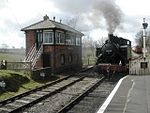Doulting Railway Cutting
English Site of Special Scientific Interest stubsGeology of SomersetRail transport in SomersetRailway cuttings in the United KingdomSites of Special Scientific Interest in Somerset ... and 3 more
Sites of Special Scientific Interest notified in 1971Somerset geography stubsUse British English from January 2018

Doulting Railway Cutting (grid reference ST648424) is a 2.8 hectare geological Site of Special Scientific Interest in Somerset, notified in 1971. The cutting was made in the 1850s for the East Somerset Railway which still runs steam trains through the cutting today. It shows rocks of the Middle Jurassic period including both the Inferior Oolite/Great Oolite Junction and the Bajocian-Bathonian stage boundary.
Excerpt from the Wikipedia article Doulting Railway Cutting (License: CC BY-SA 3.0, Authors, Images).Doulting Railway Cutting
Mendip Doulting
Geographical coordinates (GPS) Address Nearby Places Show on map
Geographical coordinates (GPS)
| Latitude | Longitude |
|---|---|
| N 51.17974 ° | E -2.50496 ° |
Address
BA4 4RE Mendip, Doulting
England, United Kingdom
Open on Google Maps










